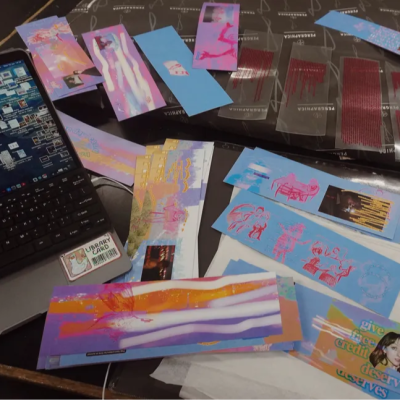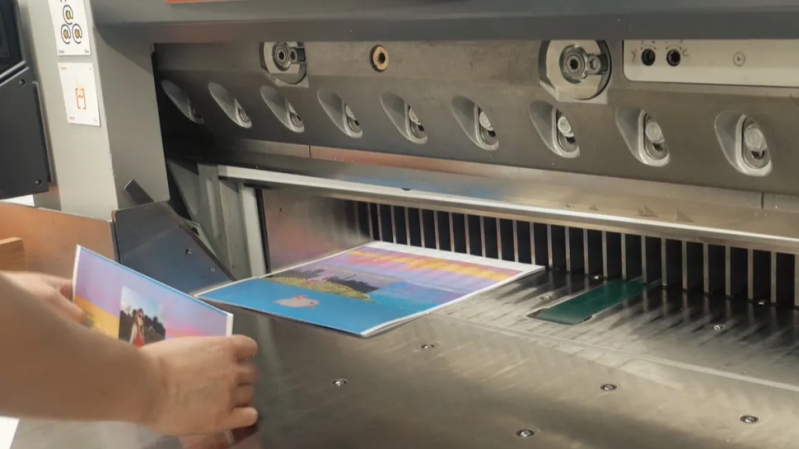Zines (self-produced, small-circulation publications) are extremely DIY, and therefore punk- and hacker-adjacent by nature. While they can be made with nothing more than a home printer or photocopier, some might benefit from professional production while losing none of their core appeal. However, the professional print world has a few gotchas, and in true hacker spirit [Mabel Wynne] shares things she learned the hard way when printing her solo art zine.

[Mabel] says the most useful detail to nail down before even speaking to printers is the zine’s binding, because binding type can impact layout and design of an entire document. Her advice? Nail it down early, whether it’s a simple saddlestitch (staples through a v-shaped fold of sheets), spiral binding (which allows a document to lay flat), or something else.
Aside from paper and print method (which may be more or less important depending on the zine’s content) the other thing that’s important to consider is the finishing. Finishing consists of things like cutting, folding, and binding of the raw printed sheets. A printer will help arrange these, but it’s possible to do some or even all of these steps for oneself, which is not only more hands-on but reduces costs.
Do test runs, and prototype the end result in order to force unknown problems to the surface before they become design issues. Really, the fundamentals have a lot in common with designing and building kits or hardware. Check out [Mabel]’s article for the full details; she even talks a little about managing money and getting a zine onto shelves.
Zine making is the DIYer’s way to give ideas physical form and put them into peoples’ hands more or less directly, and there’s something wonderfully and inherently subversive about that concept. 2600 has its roots in print, but oddball disk magazines prove one doesn’t need paper to make a zine.
















Old hacker-ajacent guy says: “Back in my day, sonny, we were lucky if we had access to a mimeograph or ditto machine. Now get off my lawn!”
Mimeo or later grainy photocopy. The essence of the zine is:
– its imperfection and DIY nature
– its content, that typically would not get published
This guy never has to pay $10 for the seat cause he only needs the EEEEDGE!!!!
Lighten up, Francis
Sounds like someone hasn’t had the pleasure of punching Ian McKaye in his effing face because “Someone I know works there so I can go behind the counter and grab a magic marker and give myself a make-believe tattoo.” It was wonderful banning that ass from my store, and it wasn’t even my store..
Brian Baker, late of Bad Religion, previously Minor Threat and Dag Nasty: “We’ll just put an ad in the paper and say “punk band wants to sell van.”
Name me a punk who didn’t grow up in an upscale neighborhood and didn’t have a fallback. You can’t.
Punk equals a-hole in my book.
Y’know what’s not punk? Gatekeeping. How about you stay in yours, o arbiter of truth.
Being against gatekeeping is the ideology of a tapeworm.
Being against gatekeeping is the business model of a door seller.
Being against gate-keeping is the whine of the suburbanite poser. Some people should be gate-kept. The city planner for Portland OR is a former and current punk (Dag Nasty, The Willows). I’m not saying “You should move to Russia! It’s the wild west!” as idiots who were afraid of life used to say. But you are free to move to Portland if that seems good to you. I’ll help you pack.
Look, disregarding all the talk about gatekeeping, after reading the article, it seems more like overcomplicated self publishing.
I think for most people, ‘zine’ means something that’s cut and pasted on letter sized sheets, and photocopied wherever you could find a copy machine. The fancy ones had flashy, bright orange, or pink cardstock covers.
I’ve made photocopied comics, and self published soft and hardcover books, and none of it was as complicated as what was laid out in the linked article.
The thing about zines is that they are about getting your ideas out there using what you have at hand. The article said she needed the help of four technicians?
Yep. “Zines” are an expression of culture and community. Printing stuff is simply printing stuff. A stack of copied paper is just a stack of copied paper, and pretending it’s a “zine” because you made it yourself is posing.
It’s the same sort of annoyance as “life hacks” or forced memes.
Or, people who mistake amateur publications for “zines” are not differentiating the media from the medium.
Yall a bunch of gatekeepers trying to ascribe some mystical whoaness to nothing special at all,
Webster says “a magazine especially, a noncommercial often homemade or online publication usually devoted to specialized and often unconventional subject matter ”
So an amateur publication that in any way shape or form resembles a magazine is a ZINE, pretending its anything else to denigrate others efforts is just weakass hipster elitism flexing at the wind.
The Webster definition makes no sense, because then every small stack of photocopied paper stapled together is a “zine”.
Yep, and you can smoke René Magritte’s pipe. It’s cargo cult culture.
Note that there would be no problem for you to call it your “amateur self published magazine”. You can do that any day of the week.
Calling it a “zine” implies you actually have a following and a “scene” behind you.
……weakass hipster elitism flexing at the wind
Well, the alternative is that “zine” is just a meaningless neologism that has gone out of fashion anyways, so why do you think it’s so important to say it?
It’s because it gives you the impression of having or being something that you aren’t.
Pretty fly for a white guy.
Even the original article admits it in a roundabout way:
“The market is full of zines created by a collection of designers looking to make something for the sake of it. The very origins in zine-making are anti-commercial: its original purpose is to get a message across outside the constraints of traditional publishing. ”
I.e. it’s a scene that was taken over by posers with nothing to say, who are simply in it to sell stuff and promote themselves. They’re re-using the aesthetics for commercial purposes, which is inverting the whole idea. All form and no function. Calling it a “zine” instead of “booklet” or some other more descriptive term is simply an act of cultural appropriation and pretense that you’re “in” something.
“outside the constraints of traditional publishing”
So an amateur publication…
“Calling it a “zine” instead of “booklet or some other more descriptive term”
Booklet is defined as “A short, nonserial printed work, often with a paper cover. So if you begin your endeavor with the intent of having more than the one edition, it is not a booklet. It is a magazine as that is defined as “a periodical publication containing articles and illustrations, typically covering a particular subject or area of interest.”
Abridging the word to “zine” to denote the noncommercial amateur nature of the work is ACTUALLY the MORE descriptive term.
Attaching some bullshit feels based connotation is just you engaging in weakass hipster elitism flexing at the wind to gatekeep. You dont get a following without beginning your publication, and any interest that exists has people who also share that interest and would comprise a “scene” if you absolutely insist upon clinging to your teenage angst based mentality.
One of the best
https://en.wikipedia.org/wiki/Factsheet_Five
I work in public transit and we are by law required to give drivers printed booklets with their duties and rosters. The price of these booklets is enormous, about 5 (euro) cent per (A6) page, which counts up to a lot if it’s 300 pages, for 200 drivers (so order 250 for temps etc).
I have often heard “Let’s do it ourselves, that’ll save costs” from depot managers, especially if it’s for a short term, like only a week of detour workings. Often, after this week, the depot manager sighs and says “next time we’re going to bring it to the printer”, because the cutting, assembling and punching holes would always take so much (paid) time.
The only booklet I usually printed and assembled myself was for a small island (1 line, 2 buses, 7 drivers, but 10 different “working days” depending on how many tourists the ferry company expected.) Explaining to the printer what needed to happen was more complex than just printing it myself.
What she describes is what I was taught as a sidecar for a CA state Graphic Design Certification program it was called “Production Art” (a state ‘Award’ certificate in 2004) and also went on into mounting, framing and presentation, beyond print and bind…
“(1 line, 2 buses, 7 drivers, but 10 different “working days” depending on how many tourists the ferry company expected.) Explaining to the printer what needed to happen was more complex than just printing it myself.”
It’s not the printer’s job to understand what needed to happen, it’s your job to produce print ready copy. It sounds like you don’t understand how printing works. The printer is not your padewan.
It sounds like the print job depended on a lot of IF statements.
If you’re treating the printer as just a dumb printer, you’d have to print every permutation, which would waste a lot of time and money on all sides. Printing just the thing you need would either require explaining it to the printer, or doing it yourself.
It’s not a zine if you print it yourself.
It’s not a zine if you have someone else print it.
QED zines do not exist.
It’s not wrong though.
Making your own “zine” without any sort of cultural movement or an idea behind it is at best a forced meme. It’s like open source without the community. It’s just you.
The typical D.I.Y./punk rock zine is usually made on a copy machine,folded and bound with staples. To have it printed on a traditional offset press is expensive, or it was costly in the 1990s.
I had a couple friends that managed a Kinkos and I could get my zine printed(approximately 100 zines with 16 to 32 pages) for almost nothing. I did a run of 500 32 page issue on newsprint and it was a bit pricey but fun to publish it. (Spiked Impalement #8 Winter 1997)
can someone identify the latptop / tablet in the image embedded in this article?
It looks to me like a MacBook of some sort with a slim keyboard placed on top of the inbuilt keyboard.